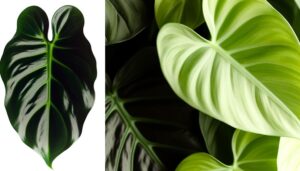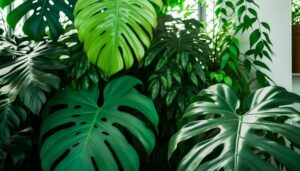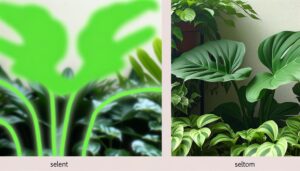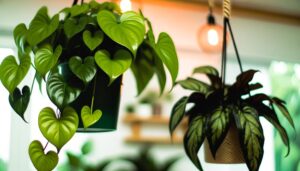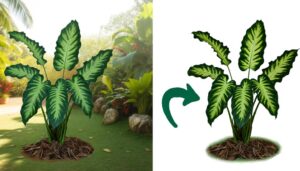Philodendron Hederaceum Vs Micans: A Quick Comparison
Philodendron hederaceum and Philodendron micans exhibit distinctive characteristics. Hederaceum’s glossier, smoother leaves contrast with the velvety, matte leaves of micans, which possess trichomes to reduce transpiration.
Hederaceum typically appears vibrant green, whereas micans shows a spectrum from deep green to bronze, influenced by light and environment. Hederaceum grows vigorously, developing extensive vines, while micans grows slower, concentrating on leaf texture.
Both thrive in bright, indirect light, maintaining a temperature range of 65°F to 80°F. Precision in watering and 60-80% humidity are essential for their health.
These subtle differences reveal fascinating details about their cultivation and care.
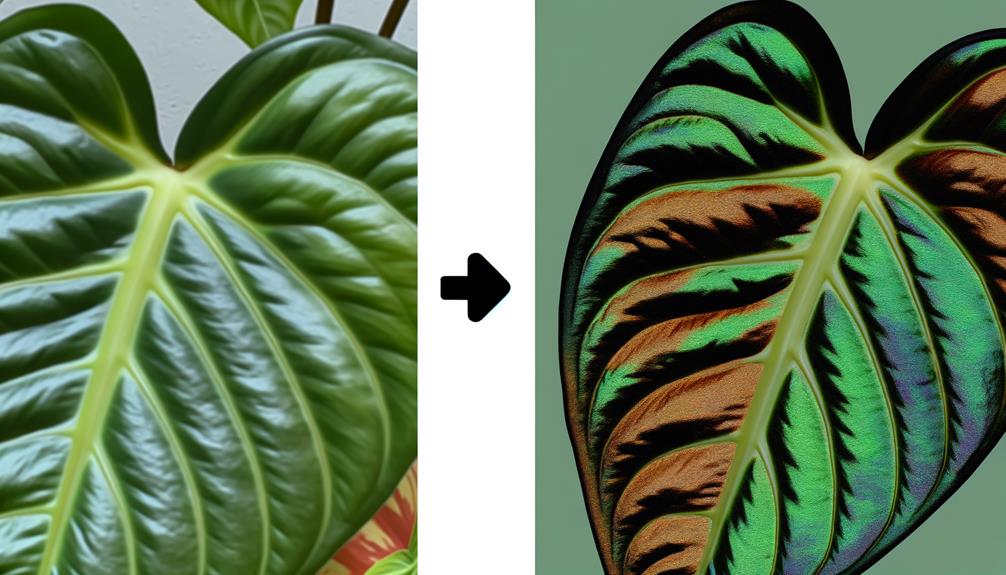
Key Takeaways
- Philodendron hederaceum leaves are smoother and glossier, whereas micans leaves are velvety and matte.
- Hederaceum features vibrant green leaves, while micans’ leaves range from deep green to bronze with reddish undertones.
- Hederaceum grows vigorously with extensive vines, while micans grows slower, focusing on developing velvety leaves.
- Both species prefer bright, indirect light and temperatures between 65°F to 80°F.
- Ideal humidity for both plants is 60-80%, with careful watering to avoid root rot.
Philodendron Hederaceum vs. Micans: Key Differences in Appearance and Care
| Feature | Philodendron Hederaceum | Philodendron Micans |
|---|---|---|
| Leaf Texture | Smooth and glossy | Velvety, with a soft, suede-like texture |
| Leaf Color | Bright green to dark green | Dark green with bronze, purple, or iridescent undertones |
| Growth Habit | Vining or trailing | Vining or trailing |
| Light Requirements | Low to medium indirect light | Low to medium indirect light |
| Watering Needs | Moderate, let soil dry out slightly between watering | Moderate, prefers consistent moisture but tolerates slight drying |
| Size | Can grow up to 10-20 feet long | Typically grows to 6-10 feet long indoors |
| Native Habitat | Tropical regions of Central and South America | Native to the Caribbean and parts of Central America |
| Distinct Feature | Classic heart-shaped leaves | Unique velvety leaves with striking coloration |
Leaf Texture
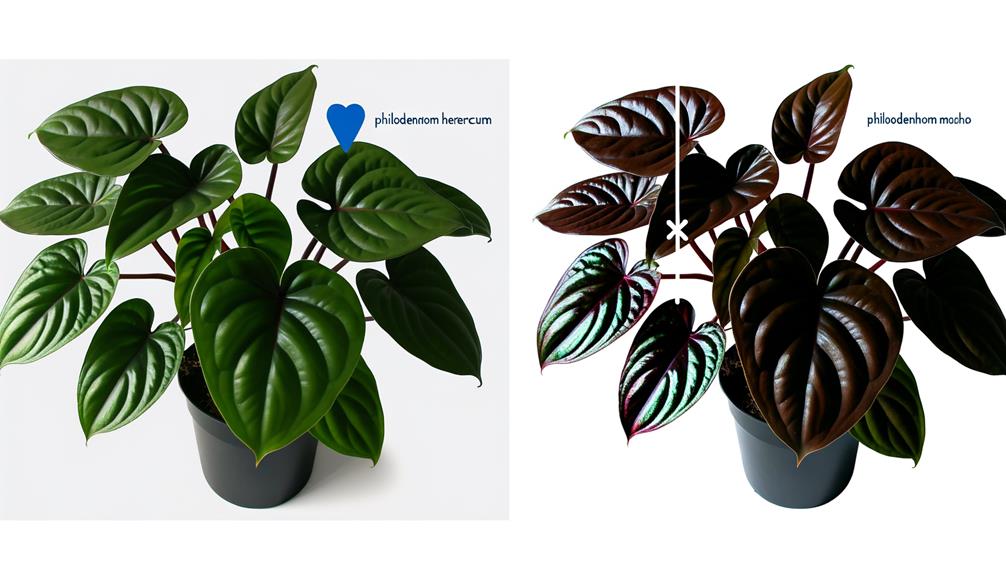
Philodendron hederaceum and Philodendron micans exhibit distinct differences in leaf texture.
With the former having a smoother, glossier surface and the latter displaying a velvety, matte finish.
Philodendron hederaceum leaves possess a waxy cuticle layer that imparts a reflective sheen, enhancing light absorption and reducing water loss.
This texture facilitates efficient photosynthesis and moisture retention, essential for its epiphytic lifestyle.
Conversely, Philodendron micans leaves are characterized by a fine layer of trichomes, creating their velvety appearance.
These trichomes can reduce transpiration by trapping a layer of still air, thereby mitigating water loss.
Additionally, the matte texture of P. micans may offer camouflage against herbivores, blending seamlessly into the understory environment.
Leaf Color
Examining leaf color reveals notable distinctions between Philodendron hederaceum and Philodendron micans, with the former typically exhibiting a vibrant green hue while the latter showcases a range of colors from deep green to bronze with reddish undertones.
The leaf color of Philodendron hederaceum remains relatively consistent, highlighting a bright, uniform green indicative of its species. Conversely, Philodendron micans presents a more dynamic palette, where the adaxial surface may appear velvety with a spectrum of hues influenced by light exposure and growth conditions.
The interplay of color in P. micans is often accentuated by its velutinous texture, creating a visually striking appearance. These chromatic differences are essential for accurate identification and understanding of each species’ unique aesthetic and physiological characteristics.
Growth Rate
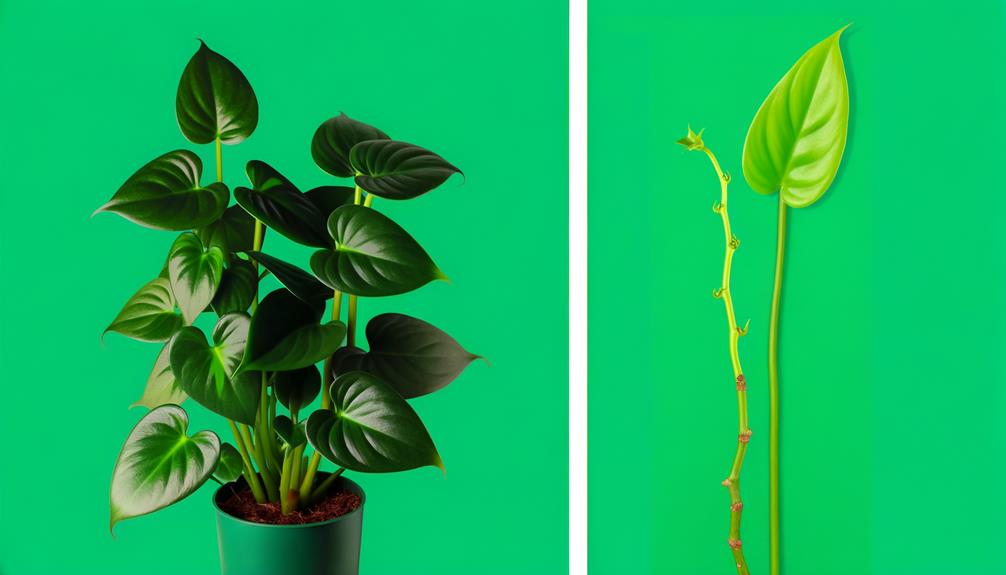
Considering growth rate, Philodendron hederaceum generally exhibits a more vigorous and rapid development compared to the relatively slower-growing Philodendron micans.
Hederaceum benefits from a robust growth habit, often producing extensive vines and foliage within a short time frame under ideal conditions. This species can quickly cover trellises or walls, making it a popular choice for dynamic greenery.
Conversely, Philodendron micans grows at a more measured pace. Although micans can eventually achieve considerable size, its growth is characteristically gradual and incremental. Detailed observations indicate that micans allocates more resources towards developing its distinctive, velvety leaves, resulting in slower overall expansion.
Understanding these growth rate differences is essential for horticulturists and home gardeners in planning space and care requirements.
Light Requirements
When comparing the light needs of Philodendron hederaceum and Philodendron micans, it is essential to take into account their best light conditions, tolerance to low light, and response to direct sunlight.
Both species thrive in bright, indirect light, but can adapt to lower light environments with varying degrees of success. However, exposure to direct sunlight can lead to leaf burn and other photodamage in both plants.
Optimal Light Conditions
Both Philodendron hederaceum and Philodendron micans thrive in bright, indirect light, which closely mimics their natural understory habitat in tropical forests. These ideal light conditions promote healthy growth and vibrant foliage.
To achieve this, consider the following guidelines:
- Light Intensity: Place the plants near east or north-facing windows where they receive filtered sunlight. Avoid direct sunlight, which can scorch the leaves.
- Duration: Provide 10-12 hours of indirect light daily to match their natural photoperiod.
- Supplemental Lighting: During darker months, use grow lights to maintain consistent light levels. Position the lights 12-18 inches above the plants.
Low Light Tolerance
Philodendron hederaceum and Philodendron micans demonstrate a significant degree of tolerance to low light conditions, although their growth rate and foliage vibrancy may diminish under such circumstances. Both species can adapt to lower light environments, making them suitable for indoor spaces with limited natural light.
However, it is important to note that prolonged exposure to low light can lead to etiolation, where stems become leggy and leaves smaller and paler. Regular monitoring and occasional rotation of the plants can mitigate some adverse effects.
Despite their resilience, providing indirect, bright light will enhance their overall health and aesthetic appeal. Employing artificial grow lights can also be beneficial in maintaining ideal conditions when natural light is insufficient.
Direct Sunlight Impact
Exposure to direct sunlight can cause significant stress to Philodendron hederaceum and Philodendron micans, resulting in leaf scorching and decreased energy. Both species thrive ideally under indirect light conditions, which mimic their natural understory habitat.
The adverse effects of direct sunlight include:
- Leaf Scorching: High-intensity light can damage chlorophyll, leading to brown, crispy edges.
- Dehydration: Excessive sunlight accelerates water loss, stressing the plant’s vascular system.
- Energy Imbalance: Excess light disrupts the photosynthetic efficiency, reducing overall vigor.
For optimal growth, place these Philodendrons in bright, indirect light to make sure they receive adequate illumination without the harmful effects of direct exposure. Utilizing sheer curtains or positioning them a few feet away from windows can effectively mitigate these risks.
Watering Needs
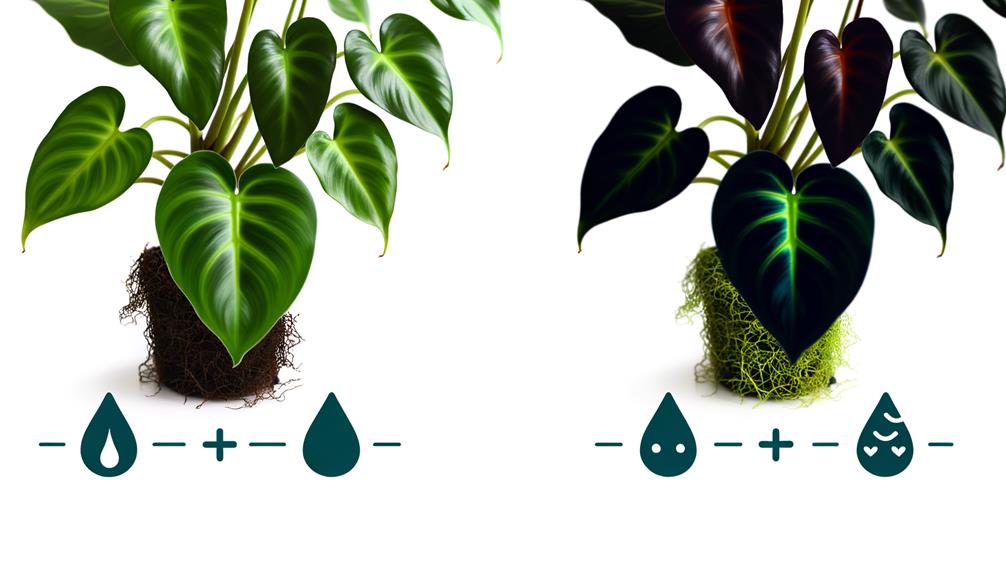
Proper watering is essential for maintaining the health of Philodendron hederaceum and Philodendron micans, as both species require a balance between hydration and aeration to prevent root rot and promote ideal growth.
Both plants thrive best when their soil is allowed to partially dry out between waterings. Over-watering can lead to saturated soil, creating an anaerobic environment detrimental to root health. Conversely, under-watering can cause dehydration stress, inhibiting growth.
| Aspect | Recommendations |
|---|---|
| Watering Frequency | Moderately; allow top 1-2 inches of soil to dry |
| Watering Method | Evenly moist soil; avoid waterlogging |
| Indications of Over-Watering | Yellowing leaves, soggy soil |
| Indications of Under-Watering | Wilting, dry soil |
| Environmental Conditions | Adjust watering based on humidity and season |
Adhering to these guidelines ensures ideal hydration, fostering robust plant health.
Soil Preferences
Selecting the appropriate soil mix is necessary for maximizing the growth conditions of Philodendron hederaceum and Philodendron micans, as both species flourish in well-draining, aerated substrates that prevent waterlogging and promote healthy root development. A scientifically formulated soil mix should include the following components:
- Peat Moss: Enhances moisture retention while maintaining aeration, important for root respiration.
- Perlite or Pumice: Improves drainage and prevents soil compaction, ensuring roots do not become waterlogged.
- Bark Chips: Adds organic matter, supporting microbial activity and further enhancing aeration.
These elements combine to create an ideal environment for nutrient uptake and root health. Ensuring these components are present in the soil mix will significantly improve the growth and health of both Philodendron species.
Temperature Tolerance
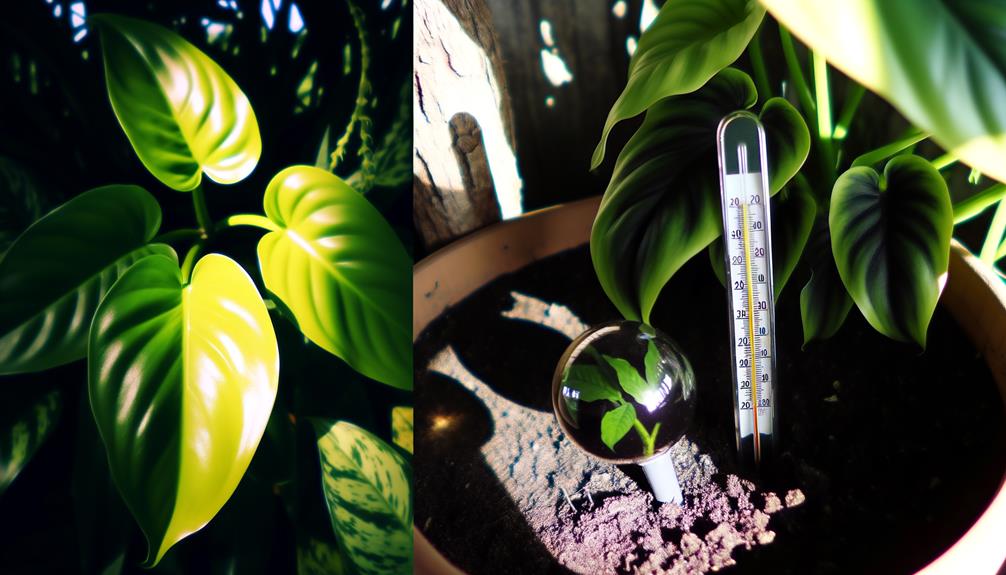
Philodendron hederaceum and Micans exhibit distinct temperature tolerances, with both species thriving within an ideal range of 65-80°F (18-27°C).
However, Micans demonstrates slightly greater resilience to colder temperatures, tolerating dips to approximately 55°F (13°C), whereas Philodendron hederaceum may suffer damage below 60°F (16°C).
Understanding these differences is essential for proper cultivation and ensuring the health of each plant.
Optimal Temperature Range
Maintaining an ideal temperature range is crucial for the health and growth of both Philodendron hederaceum and Philodendron micans. These species typically thrive in environments between 65°F to 80°F (18°C to 27°C). Proper temperature maintenance ensures peak metabolic activity, photosynthesis efficiency, and overall plant vigor.
Key considerations for maintaining this temperature range include:
- Indoor Climate Control: Utilize HVAC systems to maintain consistent temperatures within the ideal range.
- Microclimate Management: Position plants away from drafts, heating vents, and direct sunlight to prevent temperature fluctuations.
- Monitoring Tools: Employ digital thermometers and hygrometers to track ambient conditions closely.
Adhering to these guidelines will substantially contribute to the robust growth and longevity of these Philodendron species.
Cold Tolerance Limits
Given their tropical origins, both Philodendron hederaceum and Philodendron micans exhibit limited tolerance to cold temperatures, with significant stress and potential damage occurring below 55°F (13°C). Exposure to temperatures below this threshold can lead to chlorosis, stunted growth, and cellular damage.
At temperatures approaching freezing, these plants may suffer from necrosis and root system impairment. It is essential for cultivators to provide adequate protection during colder months, such as relocating plants indoors or using thermal insulation.
Monitoring ambient conditions is necessary to mitigate cold stress, ensuring these philodendrons maintain their vibrant foliage and physiological health. Understanding these temperature limitations can help in best care and prolonged plant vitality.
Humidity Needs
Best humidity levels for both Philodendron hederaceum and Micans are crucial for their growth and overall health. These tropical plants thrive in environments with high humidity, typically between 60-80%. Consistent humidity levels prevent leaf browning and promote vibrant foliage.
To maintain ideal humidity, consider the following methods:
- Humidifiers: Utilize a humidifier to maintain consistent humidity levels, especially in dry climates.
- Pebble Trays: Place a tray filled with water and pebbles beneath the plants to increase local humidity through evaporation.
- Misting: Regularly mist the leaves to provide temporary humidity boosts; however, avoid over-wetting to prevent fungal issues.
Maintaining these conditions ensures both species flourish, reflecting their native tropical habitats.
Pruning Tips
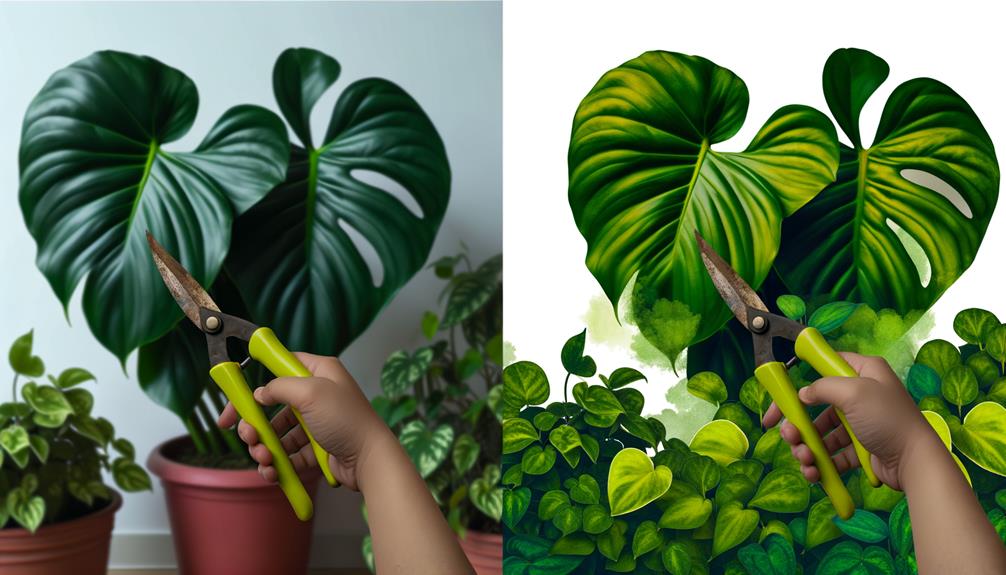
When pruning Philodendron Hederaceum and Micans, it is important to use sterilized, sharp tools to prevent infection and maintain clean cuts.
The best time for pruning is during the plant’s active growing season, usually in spring or early summer, to encourage healthy regrowth.
Paying close attention to these practices can greatly improve the overall health and visual attractiveness of these species.
Proper Pruning Tools
Consistently using sterilized, sharp pruning shears is crucial for maintaining the health and aesthetic appearance of Philodendron hederaceum and Micans. Proper pruning tools guarantee clean cuts, reducing the risk of disease and promoting robust growth. It is essential to select tools designed for precision and durability.
Consider the following criteria to ensure prime pruning results:
- Sterilization: Regularly sterilize shears with rubbing alcohol to prevent pathogen transfer.
- Sharpness: Maintain sharp blades to make clean cuts, minimizing plant tissue damage.
- Ergonomics: Choose shears with ergonomic handles to reduce hand fatigue and improve control.
Optimal Pruning Time
To maximize the benefits of using proper pruning tools, it is crucial to understand the most favorable pruning time for Philodendron hederaceum and Micans. Best pruning periods for these species align with their active growth phases, typically in spring and early summer. During these months, the plants exhibit vigorous growth, enabling quicker recovery from cuts and promoting healthy branching.
Pruning during dormancy, especially in late fall or winter, can stress the plants and potentially hinder growth. For both Philodendron hederaceum and Micans, it is recommended to avoid heavy pruning just before the flowering period, as this can reduce blooming potential. Regular, moderate pruning not only maintains plant health but also enhances aesthetic appeal, ensuring strong, lush foliage.
Propagation Methods
Propagation methods for Philodendron hederaceum and Philodendron micans primarily involve stem cuttings, which can be rooted in either water or soil. Stem cuttings should be taken just below a node, ensuring that each cutting has at least one leaf and node.
The following steps are recommended:
- Water Propagation: Place the stem cutting in a container of water, ensuring the node is submerged. Change the water weekly to prevent bacterial growth.
- Soil Propagation: Insert the cutting into moist, well-draining soil, ensuring the node is buried. Maintain high humidity and indirect light.
- Rooting Hormone: For expedited root development, dip the cut end in rooting hormone before planting in soil.
These methods enhance successful propagation and the establishment of healthy plants.
Common Pests
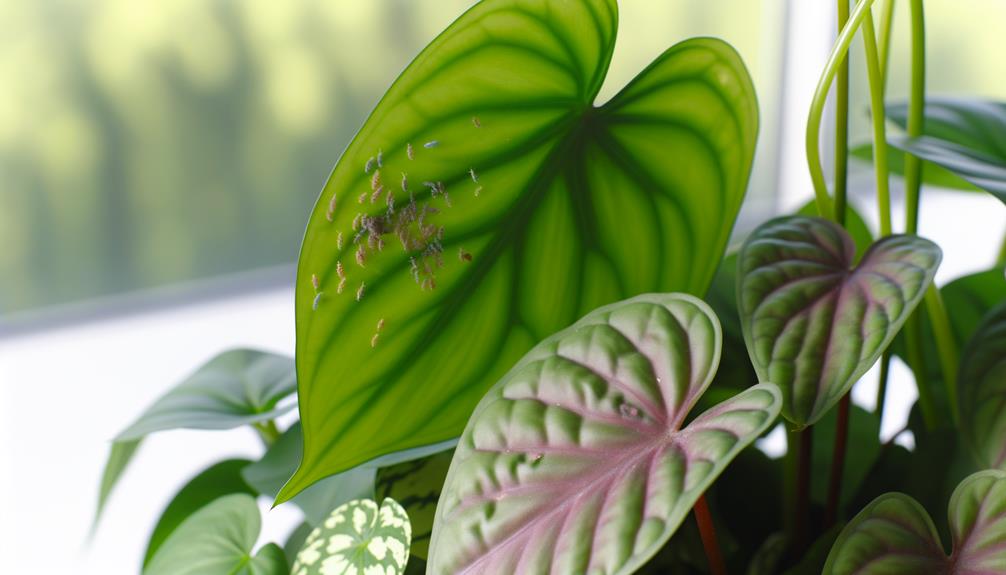
While successful propagation guarantees the growth of new Philodendron hederaceum and Philodendron micans plants, maintaining their health also demands vigilance against common pests such as spider mites, aphids, and mealybugs.
Spider mites, identifiable by their fine webbing and stippled leaf damage, thrive in dry conditions. Aphids, small and often green, feed on plant sap, leading to distorted growth and honeydew excretion, which invites sooty mold. Mealybugs, covered in a white, cotton-like substance, can cause yellowing leaves and stunted growth.
Regular inspection and early intervention using insecticidal soap or neem oil are critical. Additionally, maintaining ideal humidity and cleanliness can deter these pests, ensuring the sustained health of both Philodendron hederaceum and Philodendron micans.
Overall Aesthetic
The overall aesthetic of Philodendron hederaceum and Philodendron micans is distinguished by their unique foliage characteristics and growth habits, which can greatly enhance indoor botanical collections. Philodendron hederaceum features heart-shaped leaves with a glossy, dark green surface, while Philodendron micans boasts velvety, heart-shaped leaves with a shimmering, bronze-green hue.
Their aesthetic differences can be summarized as follows:
- Leaf Texture: Philodendron hederaceum has smooth, glossy leaves, whereas Philodendron micans displays a soft, velvety texture.
- Coloration: Philodendron hederaceum maintains a consistent dark green, while Philodendron micans exhibits a dynamic interplay of green, bronze, and pink undertones.
- Growth Habit: Both species are vining, but Philodendron micans tends to have a more delicate and cascading growth pattern.
These attributes collectively contribute to their distinct visual appeal.
Conclusion
In comparing Philodendron hederaceum and Philodendron hederaceum var. micans, it becomes evident that differences in leaf texture, color, growth rate, and care requirements notably influence their cultivation.
Both species require specific light and watering conditions, and are susceptible to common pests.
Proper pruning and propagation techniques are essential for maintaining plant health.
This analysis underscores the necessity for detailed understanding of species-specific requirements to optimize growth and aesthetic appeal in varied horticultural environments.


